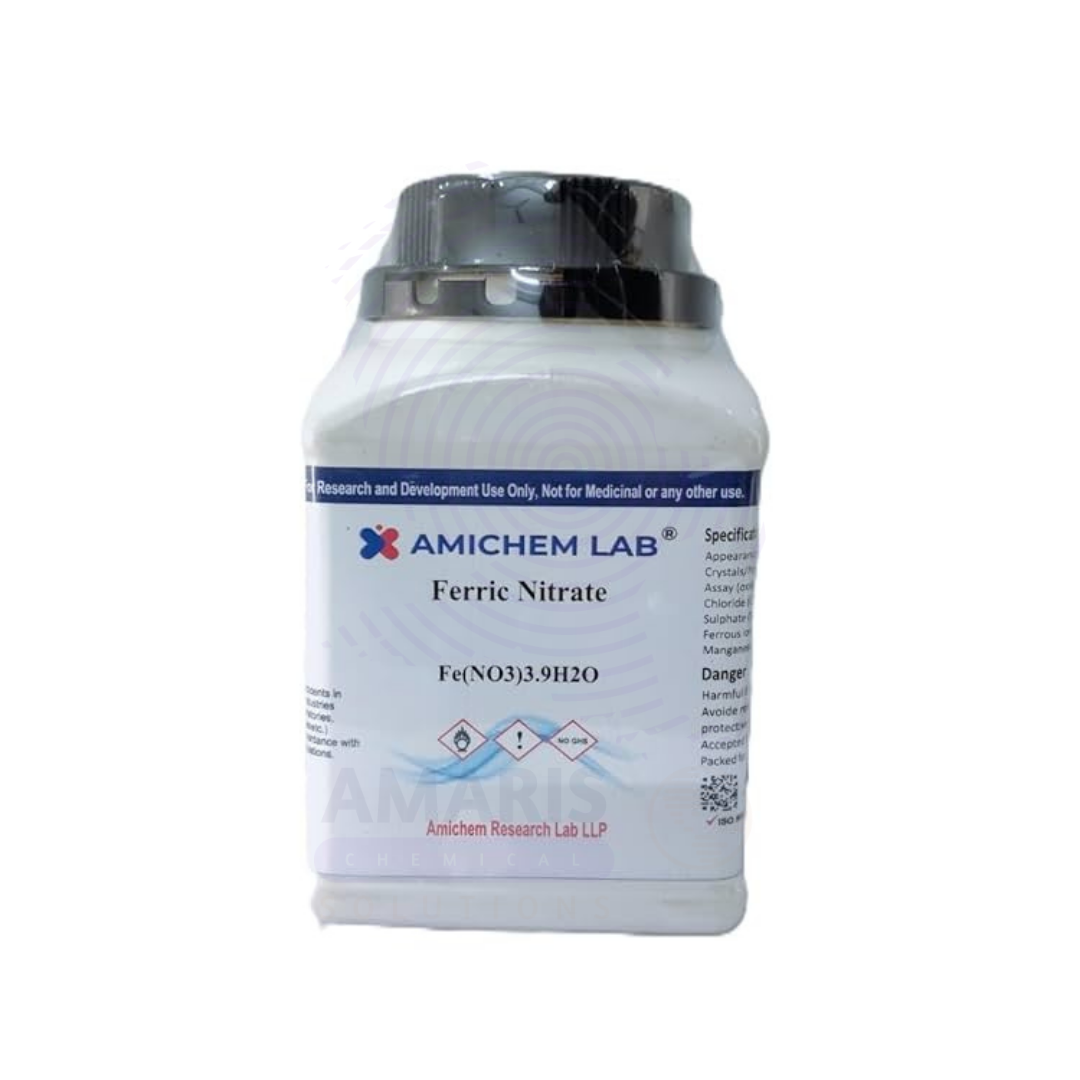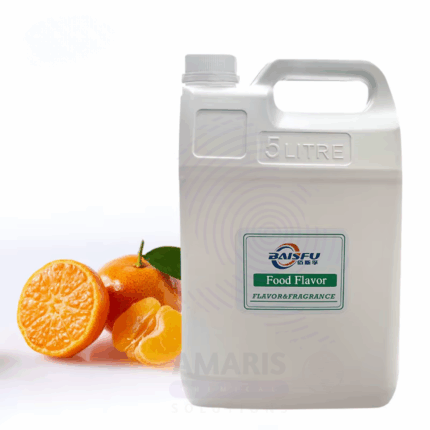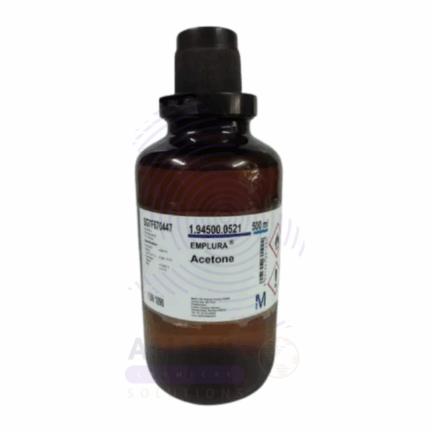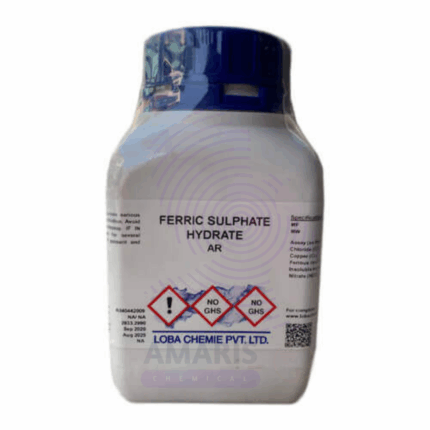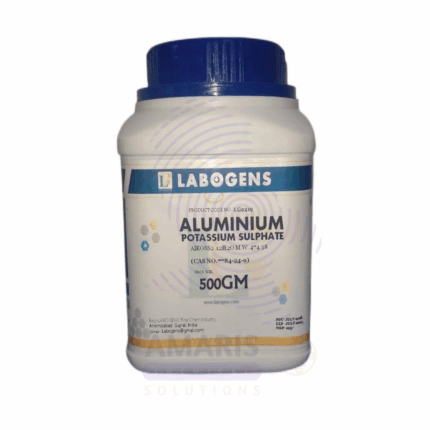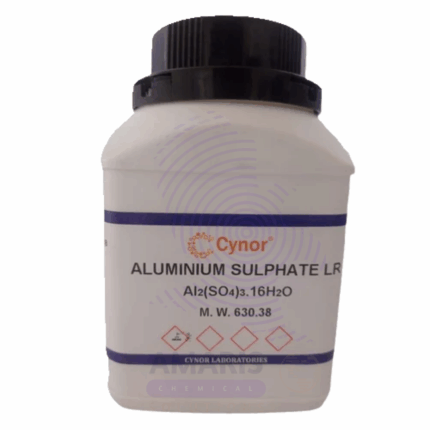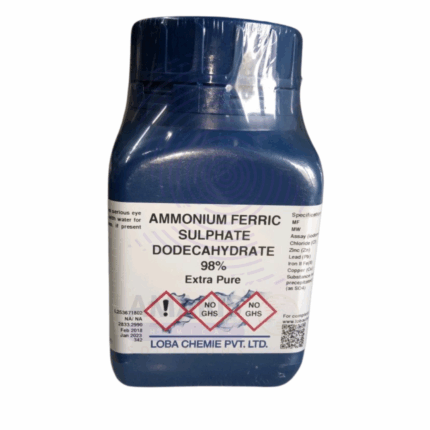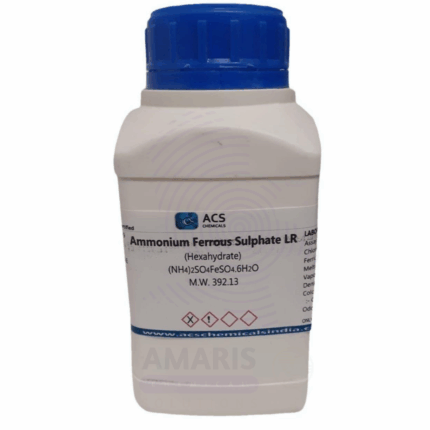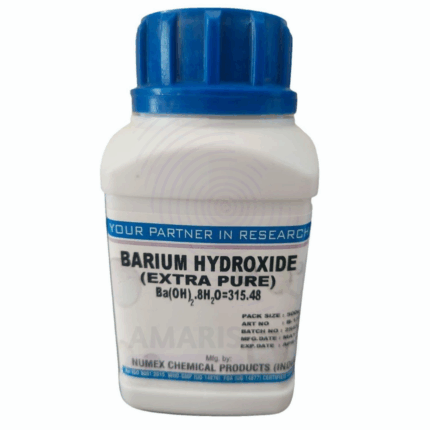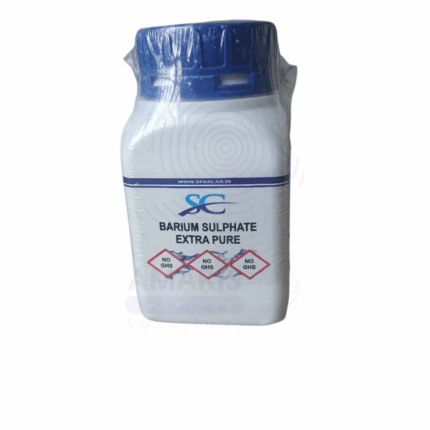“Barium Sulphate Extra pure” has been added to your cart. View cart
Back to products
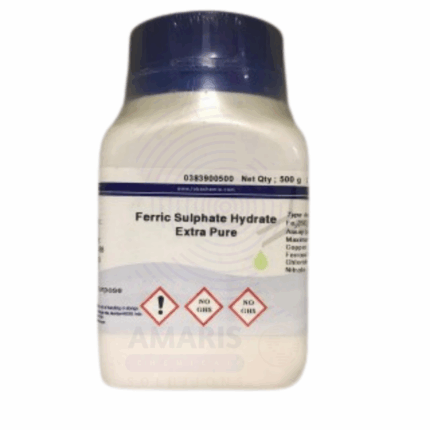

Ferric Sulphate Extra Pure
$ 17.20 Original price was: $ 17.20.$ 17.08Current price is: $ 17.08.
Ferric Nitrate Extra Pure
$ 20.10 Original price was: $ 20.10.$ 19.98Current price is: $ 19.98.
Whatsapp Order
Ferric Nitrate Extra Pure is a high-purity iron(III) salt (Fe(NO₃)₃) commonly used in analytical chemistry, inorganic synthesis, and qualitative analysis. In the lab, it serves as an oxidizing agent and a source of ferric ions in solution. It’s also employed in the preparation of coordination compounds, as a catalyst, and in various colorimetric tests. Its extra pure grade ensures low levels of contaminants, making it suitable for precision laboratory applications.
Description
Table of Contents
Toggle
Ferric Nitrate Extra Pure
Primary Uses
- Oxidizing agent in chemical reactions:
Acts as a strong oxidizer in various redox reactions and organic transformations. - Source of iron(III) ions in solution:
Commonly used to provide Fe³⁺ ions in analytical chemistry, coordination complex studies, and titrations. - Preparation of iron coordination compounds:
Used in synthesizing iron-containing complexes for research and teaching in inorganic chemistry. - Precipitation reactions and qualitative analysis:
Reacts with suitable anions (e.g., thiocyanate, phosphate) for identification or demonstration purposes.
Secondary Uses
- Catalyst in organic synthesis:
Functions as a Lewis acid in some catalytic processes. - Demonstrating corrosion and rust chemistry:
Useful in simulating oxidation processes involving iron. - Nutrient solution additive in plant biology studies:
Occasionally used in hydroponic experiments for iron supplementation in trace amounts. - Coloration studies in ceramic and glass experiments:
Can be used as a colorant to introduce iron-based hues during high-temperature testing.
Additional information
| PACK SIZE |
500 grams Plastic Tin |
|---|
KEY PRODUCT FEATURES
1. Basic Identification Attributes
- Chemical Name: Ferric Nitrate
- Synonyms: Iron(III) nitrate nonahydrate, Iron nitrate
- Chemical Formula: Fe(NO₃)₃·9H₂O
- Molecular Weight: 404.00 g/mol
- Grade: Extra Pure (Laboratory Reagent Grade)
- Appearance: Violet to reddish-brown crystalline solid
- Odor: Odorless
2. Physical & Chemical Properties
- Melting Point: ~47 °C (decomposes above 125 °C)
- Solubility: Highly soluble in water and alcohol
- pH (1% soln): Acidic
- Hygroscopic: Yes
- Decomposition: Produces nitrogen oxides and iron oxides
3. Safety & Hazard Attributes
- GHS Classification:
- Oxidizing solid (Category 3)
- Acute toxicity (Oral, Category 4)
- Eye irritation (Category 2A)
- Hazard Statements:
- H272: May intensify fire; oxidizer
- H302: Harmful if swallowed
- H319: Causes serious eye irritation
- PPE Requirements:
- Gloves (nitrile or neoprene)
- Safety goggles
- Lab coat
- Use in ventilated space or fume hood
- First Aid Measures:
- Inhalation: Move to fresh air; seek medical attention
- Skin Contact: Wash with soap and water
- Eye Contact: Rinse with plenty of water for 15+ minutes
- Ingestion: Rinse mouth; do not induce vomiting; seek medical help
4. Storage & Handling Attributes
- Storage Conditions:
- Store in tightly sealed container
- Keep away from heat, moisture, and combustible materials
- Store in a cool, dry, well-ventilated area
- Handling Notes:
- Avoid contact with skin and eyes
- Avoid inhaling dust or vapors
- Keep away from reducing agents
5. Regulatory & Compliance Attributes
- CAS Number: 7782-61-8
- EC Number: 233-899-5
- UN Number: UN 1466
- Hazard Class: 5.1 (Oxidizer)
- Packaging Group: III
6. Laboratory Applications
- Primary Uses:
- Oxidizing agent in organic and inorganic syntheses
- Reagent for detection of thiocyanates and phenols
- Catalyst in nitration reactions
- Preparation of other ferric salts
- Secondary Uses:
- Etching agent for metals
- Laboratory demonstration of oxidation-reduction reactions
- Colorimetric analysis in analytical chemistry
SAFETY HANDLING PRECAUTIONS
SAFETY PRECAUTIONS
- Oxidizing and corrosive – can intensify fire
- Can cause serious eye damage and skin irritation
- Handle with gloves, goggles, and protective clothing
- Use in well-ventilated areas or fume hoods
Storage:
- Store in a cool, dry, and well-ventilated area
- Keep away from heat, organic substances, and reducing agents
- Use non-metal containers if possible
FIRST AID MEASURES
- Inhalation: Move to fresh air and seek medical attention if symptoms persist
- Skin Contact: Rinse thoroughly with water, remove contaminated clothing
- Eye Contact: Flush eyes for 15+ minutes and seek immediate medical help
- Ingestion: Do not induce vomiting; rinse mouth and seek medical attention immediately
Related products
Acetone Extra Pure
Acetone Extra Pure is a highly volatile, flammable, and colorless liquid widely used as a powerful solvent in laboratory and industrial applications. Known for its exceptional ability to dissolve a wide range of substances, it is commonly employed for cleaning laboratory glassware, thinning resins, and removing organic residues. In the cosmetics and pharmaceutical industries, acetone is used in nail polish removers and formulation processes. Its high evaporation rate and purity make it suitable for analytical procedures and synthesis work, especially where contaminant-free solvents are essential. With a distinct odor and low boiling point, Acetone Extra Pure is an indispensable reagent for both routine and specialized chemical operations.
Aluminium Ferric Sulphate Extra Pure
Aluminium Ferric Sulphate Extra Pure is a high-purity, yellowish to light brown crystalline solid composed of aluminum, iron, and sulfate ions, commonly used in laboratory settings for analytical, coordination, and inorganic chemistry research. Its dual-metal composition makes it valuable for studying metal ion interactions, flocculation processes, and as a reagent in qualitative analysis of phosphates and tannins. The compound also finds application in preparing standard solutions and in experiments related to coagulation and sedimentation. Its extra pure grade ensures consistent performance with minimal contamination, making it ideal for precise, controlled experimentation. It should be stored in tightly sealed containers in a dry, cool environment to maintain stability and prevent moisture uptake.
Aluminium Potassium Sulphate Hydrated Extra Pure
Aluminium Potassium Sulphate Hydrated Extra Pure, commonly known as potash alum, is a high-purity, colorless to white crystalline compound containing water of crystallization. It is widely used in laboratory settings for analytical chemistry, especially in the preparation of standard solutions, precipitation reactions, and as a source of aluminum ions. Its astringent and antiseptic properties also make it useful in biochemical and pharmaceutical experiments. The hydrated form offers improved handling and solubility in water, which supports its use in buffer systems and crystal growth studies. With minimal impurities, the extra pure grade ensures consistent and reliable results in sensitive research applications. It should be stored in a dry, cool environment in well-sealed containers to preserve its quality and prevent moisture loss.
Aluminium Sulphate Anhydrous Extra Pure
Aluminium Sulphate Anhydrous Extra Pure is a high-purity, white crystalline or powdery solid commonly used in laboratory chemistry as a source of aluminum ions for precipitation, titration, and coordination studies. Its anhydrous form provides a concentrated and stable option for applications requiring precise control over water content, such as analytical reagent preparation, pH adjustment, and synthesis of other aluminum salts. This compound is also used in paper sizing experiments, dye fixation, and water treatment research. The extra pure grade ensures very low levels of contaminants, supporting accurate and reproducible results in sensitive experimental work. It should be stored in airtight containers in a dry area to prevent moisture absorption and preserve its chemical integrity.
Ammonium Ferric Sulphate Extra Pure
Ammonium Ferric Sulphate Extra Pure, also known as ferric ammonium sulfate or iron alum, is a high-purity, violet to light purple crystalline compound used extensively in laboratory settings for analytical and inorganic chemistry. It serves as a reliable oxidizing agent and a standard in redox titrations, particularly in permanganometry. Its stable and non-hygroscopic nature makes it ideal for preparing standard iron solutions, studying coordination complexes, and teaching laboratory procedures involving iron(III) salts. The extra pure grade ensures minimal interference from impurities, enabling accurate and reproducible results in sensitive experiments. It should be stored in a dry, cool environment in well-sealed containers to preserve its chemical integrity.
Ammonium Ferrous Sulphate Extra Pure
Ammonium Ferrous Sulphate Extra Pure, also known as Mohr’s salt, is a high-purity, light green crystalline compound composed of ferrous sulfate and ammonium sulfate. It is widely used in laboratory settings as a stable source of ferrous ions for redox titrations, particularly in permanganometric and dichromate analyses. Its stability in air, compared to other iron(II) salts, makes it ideal for preparing standard solutions and studying oxidation-reduction reactions. This compound is also valuable in coordination chemistry and iron metabolism research. The extra pure grade ensures minimal contamination, supporting precise analytical and experimental results. It should be stored in tightly sealed containers in a cool, dry place to prevent oxidation and maintain its integrity.
Barium Hydroxide Hydrate Extra Pure
Barium Hydroxide Hydrate Extra Pure is a high-purity, white crystalline compound containing eight molecules of water of crystallization. It is widely used in laboratory chemistry as a strong base in titration, qualitative analysis, and inorganic synthesis. Its high solubility in water and strong alkalinity make it valuable for neutralization reactions, preparation of barium salts, and as a reagent for detecting sulfates, carbonates, and phosphates. In analytical applications, it is often used where precise pH control and minimal contamination are critical. The extra pure grade ensures consistent performance in high-accuracy experiments. It should be handled with care and stored in a tightly sealed container in a cool, dry place, as it is caustic and sensitive to carbon dioxide in the air, which can lead to carbonate formation.
Barium Sulphate Extra pure
Barium Sulphate Extra Pure is a high-purity, white, odorless crystalline powder known for its extreme insolubility in water and chemical inertness, making it highly useful in laboratory settings for qualitative analysis and gravimetric determinations. It is commonly employed in the detection and quantification of sulfate ions through precipitation reactions, as well as in studies involving solubility equilibria and surface chemistry. Its high density and stability also make it valuable in preparing calibration standards and radiopaque materials in research. The extra pure grade ensures minimal contamination, providing consistent and reliable results in sensitive analytical procedures. It should be stored in a dry, tightly sealed container to maintain its quality and prevent contamination.


 Preservatives(food)
Preservatives(food) Flavor Enhancers
Flavor Enhancers Acidulants
Acidulants Sweeteners
Sweeteners Antioxidants
Antioxidants Colorants(food)
Colorants(food) Nutraceutical Ingredients (food)
Nutraceutical Ingredients (food) Nutrient Supplements
Nutrient Supplements Emulsifiers
Emulsifiers
 Collectors
Collectors Dust Suppressants
Dust Suppressants Explosives and Blasting Agents
Explosives and Blasting Agents Flocculants and Coagulants
Flocculants and Coagulants Frothers
Frothers Leaching Agents
Leaching Agents pH Modifiers
pH Modifiers Precious Metal Extraction Agents
Precious Metal Extraction Agents
 Antioxidants(plastic)
Antioxidants(plastic) Colorants (Pigments, Dyes)
Colorants (Pigments, Dyes) Fillers and Reinforcements
Fillers and Reinforcements Flame Retardants
Flame Retardants Monomers
Monomers Plasticizers
Plasticizers Polymerization Initiators
Polymerization Initiators Stabilizers (UV, Heat)
Stabilizers (UV, Heat)
 Antifoaming Agents
Antifoaming Agents Chelating Agents
Chelating Agents Coagulants and Flocculants
Coagulants and Flocculants Corrosion Inhibitors
Corrosion Inhibitors Disinfectants and Biocides
Disinfectants and Biocides Oxidizing Agents
Oxidizing Agents pH Adjusters
pH Adjusters Scale Inhibitors( water)
Scale Inhibitors( water)
 Antioxidants(cosmetic)
Antioxidants(cosmetic) Emollients
Emollients Fragrances and Essential Oils
Fragrances and Essential Oils Humectants
Humectants Preservatives
Preservatives Surfactants(cosmetic)
Surfactants(cosmetic) Thickeners
Thickeners UV Filters
UV Filters
 Fertilizers
Fertilizers Soil Conditioners
Soil Conditioners Plant Growth Regulators
Plant Growth Regulators Animal Feed Additives
Animal Feed Additives Biostimulants
Biostimulants Pesticides (Herbicides, Insecticides, Fungicides)
Pesticides (Herbicides, Insecticides, Fungicides)
 Active Pharmaceutical Ingredients (APIs)
Active Pharmaceutical Ingredients (APIs) Excipients
Excipients Solvents(pharmaceutical)
Solvents(pharmaceutical) Antibiotics
Antibiotics Antiseptics and Disinfectants
Antiseptics and Disinfectants Vaccine Adjuvants
Vaccine Adjuvants Nutraceutical Ingredients (pharmaceutical)
Nutraceutical Ingredients (pharmaceutical) Analgesics & Antipyretics
Analgesics & Antipyretics
 Analytical Reagents
Analytical Reagents Solvents(lab)
Solvents(lab) Chromatography Chemicals
Chromatography Chemicals Spectroscopy Reagents
Spectroscopy Reagents microbiology-and-cell-culture-reagents
microbiology-and-cell-culture-reagents Molecular Biology Reagents
Molecular Biology Reagents Biochemical Reagents
Biochemical Reagents Inorganic and Organic Standards
Inorganic and Organic Standards Laboratory Safety Chemicals
Laboratory Safety Chemicals Specialty Laboratory Chemicals(Special Laboratory Equipment)
Specialty Laboratory Chemicals(Special Laboratory Equipment)
 Demulsifiers
Demulsifiers Hydraulic Fracturing Fluids
Hydraulic Fracturing Fluids Scale Inhibitors(oil)
Scale Inhibitors(oil) Surfactants(oil)
Surfactants(oil) Drilling Fluids
Drilling Fluids
 Dyes and Pigments
Dyes and Pigments Bleaching Agents
Bleaching Agents Softening Agents
Softening Agents Finishing Agents
Finishing Agents Antistatic Agents
Antistatic Agents
 Admixtures
Admixtures Waterproofing Agents
Waterproofing Agents Sealants and Adhesives
Sealants and Adhesives Curing Compounds
Curing Compounds Concrete Repair Chemicals
Concrete Repair Chemicals Anti-Corrosion Coatings
Anti-Corrosion Coatings
 Surfactants(cleaning)
Surfactants(cleaning) Builders
Builders Enzymes
Enzymes Solvents (Cleaning)
Solvents (Cleaning) Fragrances
Fragrances
 Electronic Chemicals
Electronic Chemicals Catalysts
Catalysts Lubricants
Lubricants Photographic Chemicals
Photographic Chemicals Refrigerants
Refrigerants Automotive chemicals
Automotive chemicals Pyrotechnic Chemicals
Pyrotechnic Chemicals
 Biodegradable Surfactants
Biodegradable Surfactants Bio-based Solvents
Bio-based Solvents Renewable Polymers
Renewable Polymers Carbon Capture Chemicals
Carbon Capture Chemicals Wastewater Treatment Chemicals
Wastewater Treatment Chemicals
 Pigments
Pigments Solvents(paint)
Solvents(paint) Specialty Coatings
Specialty Coatings Binders/Resins
Binders/Resins Additives
Additives Driers
Driers Anti-Corrosion Agents
Anti-Corrosion Agents Functional Coatings
Functional Coatings Application-Specific Coatings
Application-Specific Coatings
 Fresh Herbs
Fresh Herbs Ground Spices
Ground Spices Whole Spices
Whole Spices Spice Blends
Spice Blends Dried Herbs
Dried Herbs
 Leavening Agents
Leavening Agents Dough Conditioners
Dough Conditioners Flour Treatments
Flour Treatments Fat Replacers
Fat Replacers Decoratives
Decoratives Preservatives(baking)
Preservatives(baking)
 Plasticizers & Softeners
Plasticizers & Softeners Reinforcing Agents
Reinforcing Agents Adhesion Promoters
Adhesion Promoters Vulcanizing Agents
Vulcanizing Agents Antidegradants
Antidegradants Blowing Agents
Blowing Agents Fillers & Extenders
Fillers & Extenders Accelerators & Retarders
Accelerators & Retarders